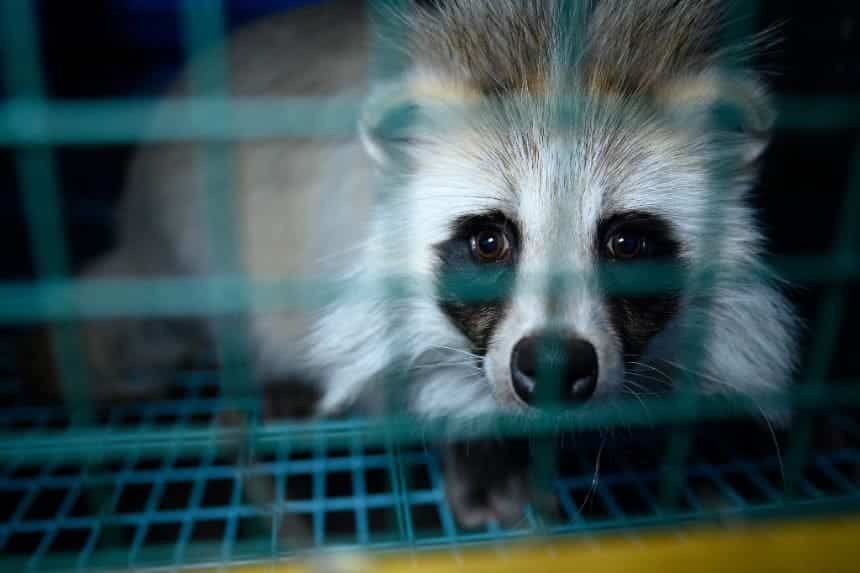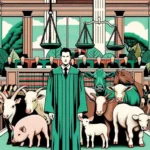A Tale of Two Laws
At the intersection of law and ethics, a revealing comparison emerges: the analogy between animal welfare law and international humanitarian law. Both realms, seemingly disparate, mirror a profound struggle—the attempt to humanize inherently violent practices. International humanitarian law strives to infuse humanity into the chaos of warfare, safeguarding those ensnared by conflict. Concurrently, animal welfare law seeks to alleviate the suffering of non-human beings entangled in society-sanctioned exploitative practices.
This analogy illuminates the shared legal and moral dilemmas we face in protecting the victims of institutionalized violence, be they human or non-human. It challenges us to explore the underlying principles that balance necessity against compassion, casting a spotlight on our efforts to moderate the stark realities of violence. By drawing parallels between the efforts to regulate human conflict and animal exploitation, we uncover a unified endeavor to extend the boundaries of empathy and legal protection.
Comparing animal welfare law with international humanitarian law raises ethical questions about legal interventions.
Herein lies an invitation to rethink the ethical and legal frameworks that shape our relationships with all sentient beings. This comparison not only highlights the complexities of the “war on animals” but also beckons us towards a more inclusive understanding of justice and care, encouraging a profound reevaluation of our duties towards the voiceless and the vulnerable in an interconnected world.
The Essence of Animal Warfare Law
The term “Animal Warfare Law” might initially strike one as a metaphorical flourish, yet it serves as a critical lens through which to examine the systematized violence perpetrated against animals within legal and normative frameworks. This conceptualization draws an unsettling yet insightful parallel to human conflict, shedding light on the pervasive battles waged against non-human beings under the guise of legality and societal norms.
Envisioning an Animal Law of Peace challenges us to reimagine our relationship with animals.
The “war on animals” encapsulates the relentless, organized violence inherent in industries and practices that exploit animals—ranging from factory farming to scientific experimentation. Like the laws that govern human warfare, which seek to impose order and humanity within the chaos of conflict, the laws surrounding animal welfare attempt a similar balancing act. They strive to mitigate suffering within the very structures that institutionalize it, aiming to humanize practices that, at their core, are anything but.
However, this comparison does more than highlight the paradoxes of animal welfare/warfare law. It prompts a deeper examination of the principles underlying our legal and moral considerations for all sentient beings. The analogy with international humanitarian law invites a reevaluation of how society legitimizes and regulates violence, urging a reflection on the extent to which compassion and ethical considerations inform these legal frameworks.
In exploring this analogy, the goal is not merely to critique but to understand—to unpack the complexities of how laws both reveal and shape societal values towards animals. It challenges the reader to consider the moral imperatives behind legal structures, questioning whether they suffice in addressing the depth of suffering inflicted in the name of human benefit. This exploration lays the groundwork for envisioning a legal and ethical landscape where the rights and welfare of animals are not just acknowledged but actively protected.
A Comparative Reconstruction
A comparative analysis between animal welfare law and international humanitarian law reveals striking structural and functional similarities in how violence is regulated. Both legal domains emerge from a foundational concern: to introduce ethical constraints into realms where violence is not only prevalent but often institutionalized. Animal welfare law, on one hand, governs the treatment of non-human animals in various contexts, aiming to mitigate the cruelty and suffering inherent in practices like factory farming, experimentation, and entertainment. International humanitarian law, on the other hand, seeks to limit the barbarity of war, protecting those who are not participating in hostilities and minimizing the suffering of combatants.
The core of this comparison lies in their shared regulatory approach to violence. Both laws operate under the presumption that while the complete eradication of violence may not be feasible given current societal norms, needs, and the very factual reality of war, its worst excesses can and should be curbed through legal means. This is achieved by setting standards that, while allowing certain forms of violence, explicitly prohibit others deemed unnecessary or excessively cruel.
Moreover, both legal frameworks grapple with the tension between necessity and compassion. They strive to balance the justifications for violence inherent in their respective fields with the moral imperative to prevent unnecessary suffering. This balancing act underscores a crucial insight: legal systems reflect broader societal values about whose suffering counts and under what conditions violence is deemed acceptable. Through this comparative lens, the parallels between animal welfare law and international humanitarian law not only highlight their mutual goals of moderating violence but also prompt a reflection on the ethical foundations underpinning legal interventions in both human and non-human contexts.
Bridging Gaps: Towards an Animal Law of Peace
The concept of an “Animal Law of Peace” draws inspiration from human laws of war and peace, proposing a transformative approach to animal protection. This visionary framework seeks to extend beyond the current confines of animal welfare law, advocating for a paradigm that not only regulates violence against animals but actively fosters their well-being and rights.
Historically, human legal systems have developed distinct mechanisms for the governance of peace and the conduct of war, each with its set of rules and principles aimed at protecting human life and dignity. Similarly, an Animal Law of Peace would introduce a comprehensive legal structure designed to protect animals from the violence inherent in industries and practices that exploit them. This would entail not just the mitigation of suffering but the promotion of conditions conducive to the flourishing of all non-human life.
Current animal welfare laws often fall short of providing adequate protections.
The need for such a law is underscored by the limitations of current animal welfare regulations, which often address the symptoms of exploitation without tackling its root causes. By drawing on the principles underlying international peacetime laws, an Animal Law of Peace would strive for the prevention of violence against animals, establishing a legal and ethical framework that recognizes their intrinsic value and rights.
Envisioning an Animal Law of Peace challenges us to reimagine our relationship with animals, moving from a paradigm of domination and exploitation to one of respect and coexistence. It calls for a global commitment to developing legal standards that reflect a deeper understanding of our ethical responsibilities towards all sentient beings. This shift represents not only a legal but a moral evolution, signaling a broader recognition of the interconnectedness of life on our planet.
The Need for a Comprehensive Legal Framework
The urgency to develop a more comprehensive legal framework for animal protection is becoming increasingly apparent in our global society. Current animal welfare laws, while important, often fall short of providing adequate protections, focusing largely on the mitigation of suffering rather than the prevention of harm and the promotion of rights. This limited scope highlights the necessity for a legal framework that encompasses both protections during exploitation and the promotion of animal rights in times of peace.
Society must move beyond the antiquated notion that animals are mere commodities or resources for human exploitation.
This comprehensive legal framework would fundamentally recognize animals as sentient beings with intrinsic value, deserving of rights and protections that extend beyond the mere alleviation of suffering. Such a framework would not only regulate the conditions under which animals are used for human purposes but also champion their right to live free from exploitation and harm. By incorporating both welfare standards and rights-based protections, the proposed framework aims to bridge the gap between current regulatory practices and the ethical imperatives of fundamental animal rights.
A key component of this comprehensive approach is the recognition of peacetime animal rights, ensuring their well-being is prioritized across all aspects of human-animal interaction. This includes legal provisions for their habitat, health, and freedom, thereby safeguarding their interests and promoting a more harmonious coexistence between humans and animals.
The development of such a framework necessitates a paradigm shift in how societies value and interact with non-human life. It requires a concerted effort from lawmakers, advocates, and the public to redefine the legal and moral boundaries of our relationship with animals, moving towards a future where their rights are not only recognized but actively protected.
Challenges and Critiques: Navigating Welfare and Rights
Navigating the complex terrain between the traditionally separated terrains of animal welfare and rights presents significant challenges and critiques, highlighting the nuanced debate within the realms of ethical treatment and legal protection of animals. This discourse is enriched by drawing an analogy with international humanitarian law, offering fresh insights into the parallels between human rights and animal protection.
The welfare approach, focused on the humane treatment and alleviation of suffering, often operates within the existing framework of animal use. It seeks to impose standards that ensure animals are kept, used, or killed with minimal suffering. However, this approach is criticized for potentially perpetuating the exploitation of animals by making it more palatable rather than challenging the ethical foundations of such practices.
In contrast, the animal rights perspective advocates for a fundamental reevaluation of animals’ moral status, arguing for inviolable rights that protect animals from being used as means to human ends. This stance is often viewed as radical, aiming to abolish rather than regulate animal exploitation. Critics argue that the rights approach may be impractical or too idealistic, failing to address immediate welfare concerns within the current societal and legal frameworks.
The analogy with international humanitarian law illuminates this debate by highlighting how laws designed for human conflict navigate similar tensions between necessity and protection, offering a model for balancing pragmatic welfare improvements with the aspirational goals of rights. This comparison suggests that a comprehensive legal framework for animals, akin to the tripartite structure of laws governing human warfare, peacetime, and rights, could reconcile these approaches. By considering animals’ welfare within the context of their rights, and vice versa, this integrated perspective encourages a more holistic understanding of animal protection that transcends the limitations of existing paradigms.
Towards a Future of Peaceful Coexistence
Advancing towards a future of peaceful coexistence requires a transformative shift in societal values and legal frameworks to protect the life and dignity of all species. This vision encompasses not just a reevaluation of our legal obligations towards animals but a deeper philosophical and ethical reconsideration of our place in the natural world.
Central to this shift is the recognition of animals as sentient beings with inherent value, deserving of respect and compassion. Society must move beyond the antiquated notion that animals are mere commodities or resources for human exploitation, towards acknowledging their complex emotional and social lives. This entails not only legal protections against cruelty and exploitation but also proactive measures to ensure their well-being and natural behaviors are respected.
The adoption of a comprehensive legal framework, as discussed, would mark a significant step in this direction, providing the necessary legal teeth to protect animal rights effectively. However, legal reform alone is not sufficient. Education plays a crucial role in fostering a culture of respect and empathy for animals, informing future generations about the importance of biodiversity and the interdependence of all life forms.
Moreover, promoting peaceful coexistence with animals requires innovative approaches to conflict resolution where human and wildlife habitats overlap. This involves developing sustainable practices that minimize human-animal conflicts and protect natural habitats, ensuring both humans and animals can thrive.
Ultimately, advancing towards a future of peaceful coexistence is a collective journey that challenges us to envision a world where the rights and welfare of all beings are interwoven into the fabric of society. It calls for a profound reimagining of our relationships with other species, guided by principles of respect, justice, and compassion.
War on Animals : A Call for Global Action
This article has traversed the complex landscape of animal welfare and rights, drawing a parallel with international humanitarian law to shed light on the systemic violence faced by animals and the legal efforts to mitigate it. The analogy not only highlights the shared moral foundations between human and animal protection but also underscores the pressing need for a comprehensive legal framework that transcends the limitations of current animal welfare laws.
The call for global action is clear: legal reforms are urgently needed to ensure animals are recognized and treated as sentient beings with inherent value. This necessitates moving beyond welfare measures that merely alleviate suffering to establishing robust rights that safeguard animals from exploitation and harm. Such a transformation requires not only legislative change but also a paradigm shift in our ethical considerations, recognizing the moral imperatives of extending compassion and justice to all sentient beings.
Advancing towards a future of peaceful coexistence with animals demands innovative legal, educational, and societal strategies. It involves reimagining our relationship with animals, fostering a culture that values biodiversity, and adopting sustainable practices that minimize human-animal conflicts. This vision of coexistence is predicated on the understanding that the well-being of humanity is intrinsically linked to the health and vitality of the natural world.
In conclusion, the journey towards a more just and compassionate world for animals is a collective endeavor that challenges us to rethink our legal systems and ethical frameworks. It calls for global action to enact legal reforms, promote education, and shift societal values, ensuring the rights and welfare of animals are not just acknowledged but actively protected. This article serves as a call to arms, urging us to embrace our shared responsibility for creating a world where all beings can live in dignity and peace.
Adaptation by Politics and Rights Review of an academic article , under license CC BY 4.0. Revised and approved by the original article’s author.






